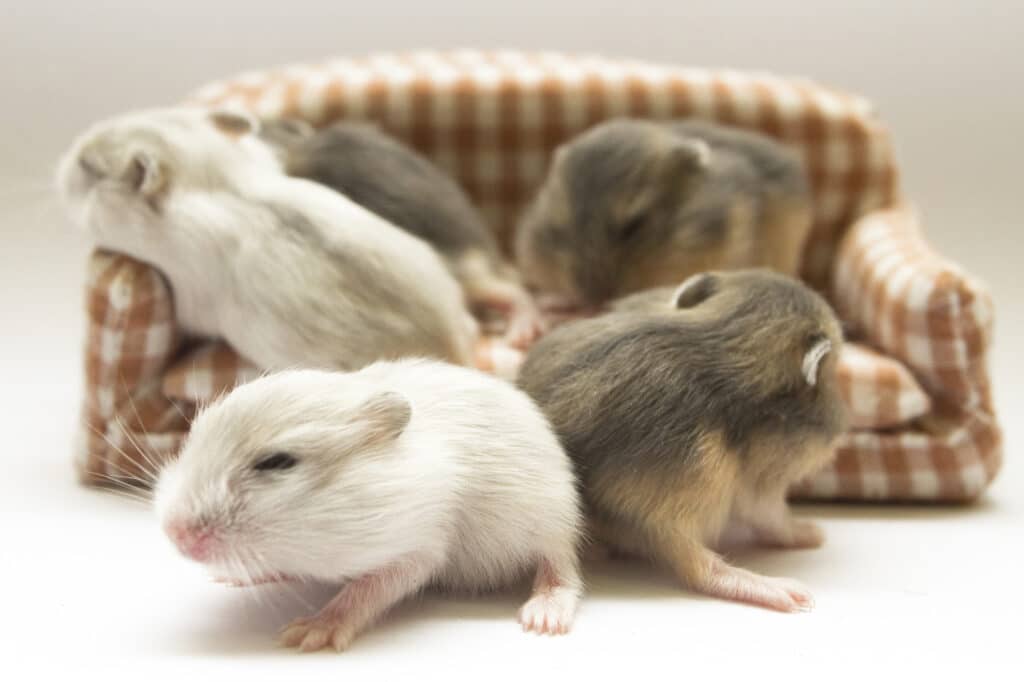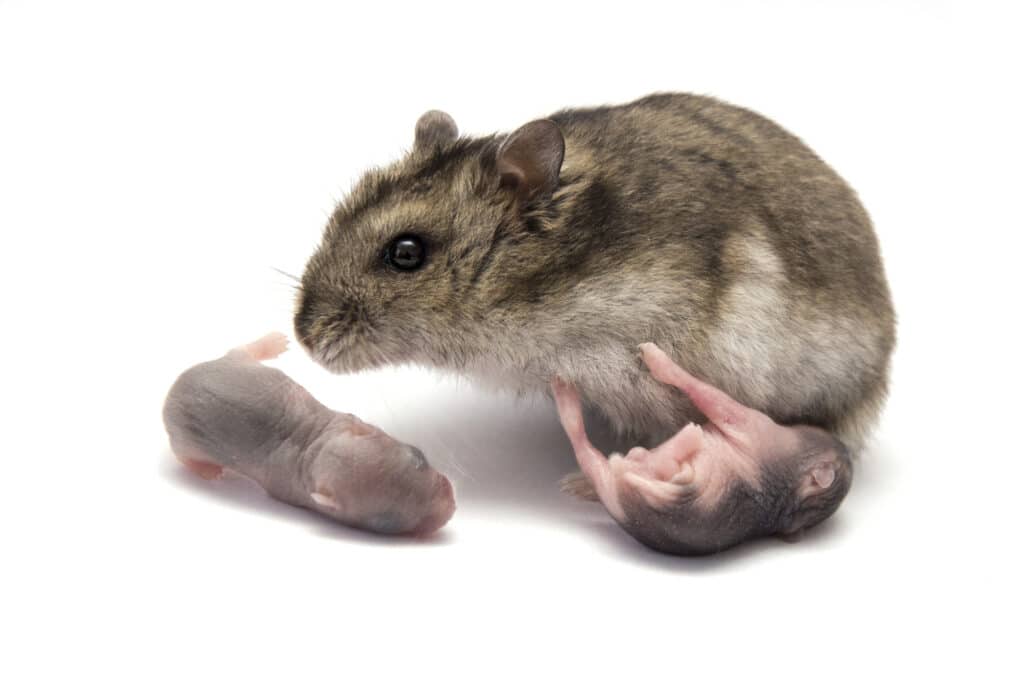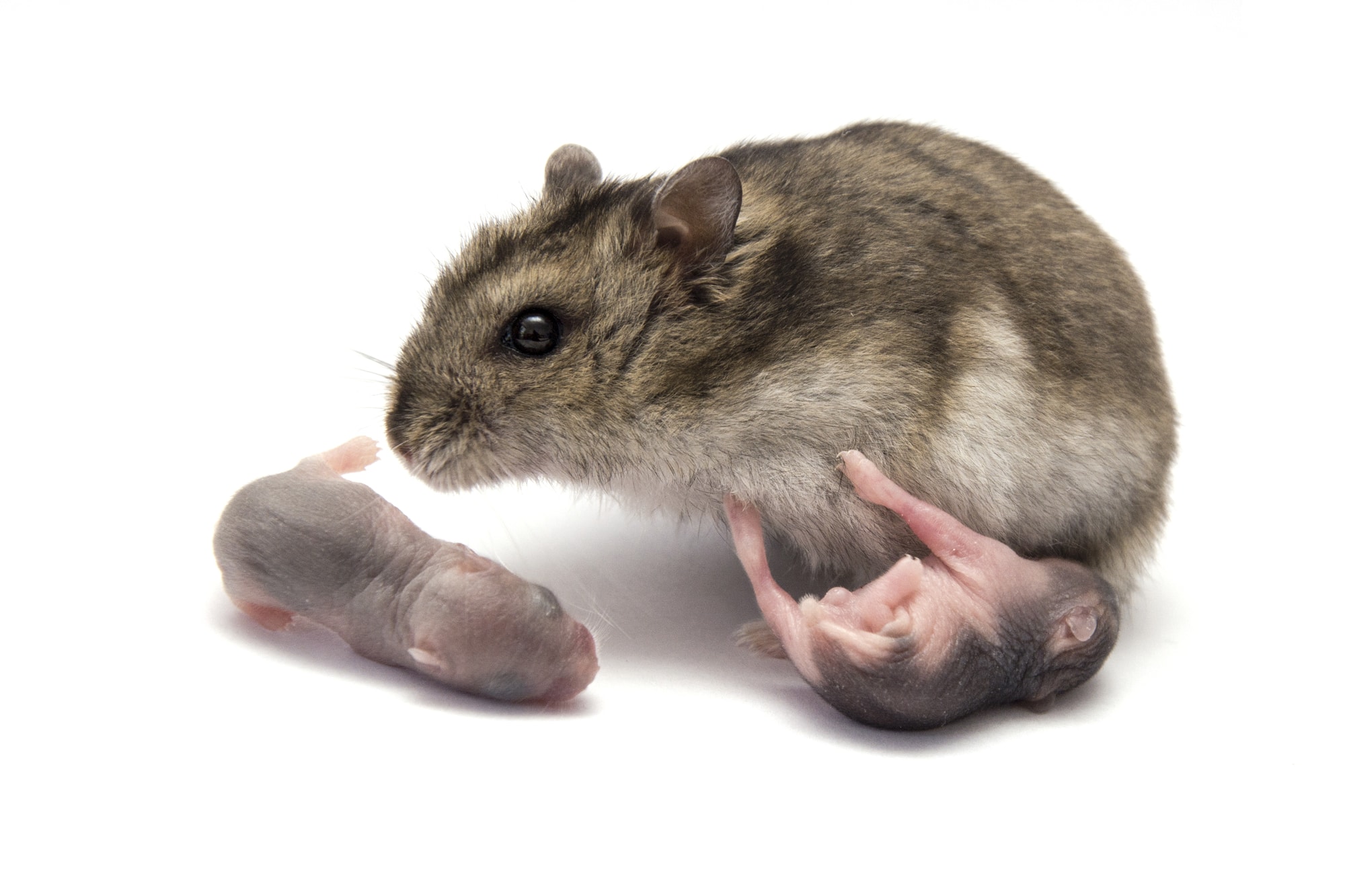In the animal kingdom, eating one’s own offspring is not such a rare occurrence, even though it is despicable, unimaginable, and unforgivable in the human realm. Hamsters are no exceptions to this. They, too, might eat their offspring. But why do hamsters eat their babies? How do you prevent it from happening again? Read this blog post to find out.
- Why do hamsters eat their babies?
- 1. Lack of experience
- 2. Stress
- 3. Unfamiliar neighborhood
- 4. Malnutrition
- 5. A big litter size
- 6. A small cage
- 7. Sick pups
- 8. Your (or foreign) scent on the pups
- 9. Perception of a threat
- 10. Accidental killing
- 11. The dad could be the culprit
- 12. Another male hamster could be the culprit
- 13. Not removing the young hamsters on time
- Should you separate the mother and the babies if you notice your hamster killing her babies?
- What should you do to prevent your hamster from killing her babies?
- Summary
Why do hamsters eat their babies?
There are several reasons why hamsters eat their own babies. These reasons are listed below:

1. Lack of experience
If a woman (human) is going through childbirth, she gets a lot of help and useful advice from the hospital, her relatives, and her friends about how to handle the situation. But a hamster doesn’t get any help or advice from anyone. She has to learn everything from her own experience.
So, if it’s the first time a hamster is going through childbirth, she may not know how to handle the changes her body goes through. She may not know how to handle her pups, either. This might be the reason why she ate one of her pups.
2. Stress
Giving birth and raising young ones is a stressful experience. This holds good not only for humans but also for hamsters. The stress might be too much for hamsters, especially young, inexperienced hamsters, to handle. Excessive stress is one of the reasons that make a hamster eat its pups.
3. Unfamiliar neighborhood
A hamster’s eyesight may be bad. But she has a good memory of where things are in her cage. If she senses a change in anything in her surroundings, she might get stressed and eat her babies. So, once a hamster becomes pregnant, do not change anything in the cage, except for removing uneaten pieces of food, at least until 2 weeks after childbirth.
4. Malnutrition
A hamster needs enough nutrition and a lot of energy during pregnancy and childbirth. So, you should ensure that you give your hamster a balanced diet. You should also provide plenty of protein-rich food, like egg whites, cooked chicken, etc., during pregnancy and childbirth. If a hamster doesn’t get enough food during these phases, she might eat her own offspring to make up for the lack of nutrients in her food.
5. A big litter size
If a hamster gives birth to too many pups and she feels that she may not be able to feed all of them, she might decide to sacrifice some to save the others. This is especially true if the nutritional demands of her body are not met by her diet. So, giving your hamster a nutrient-rich, balanced diet and fresh water is important. Once she gets enough healthy food, her body can create sufficient milk to feed all her pups.
6. A small cage
Hamsters might be tiny creatures. But they need a big cage to simulate their natural environment in the wild. If your hamster gives birth, she would need an even larger cage because she might give birth to 6 – 12 pups at a time. After childbirth, the place the hamster had for herself will be shared by 7 – 13 hamsters. So, if the mother hamster feels that the cage size is too small for her and her babies or if she feels cramped in the cage with her babies, she might kill some of them.
Therefore, if you plan to let your hamster mate and reproduce, get a cage that is significantly larger than the minimum living space required for a hamster.
7. Sick pups
If some of the hamster babies are born with disabilities or are just too weak, the mother might eat them. In the wild, hamsters that are too weak or are disabled will have a hard time surviving. Therefore, the mother hamster might eat them to recover the energy she lost during childbirth so that she can better feed and take care of the ones that have a higher chance of surviving.
8. Your (or foreign) scent on the pups
Hamsters are creatures that have bad eyesight. So, they rely on their scent glands and their sense of smell to mark and identify their siblings, parents, partners, and children. Your hamster will rely on the scent of her babies to identify them. If you touch the babies, your scent might stick to them. If that happens, your scent will make her babies appear alien to her. So, she might perceive her own babies as threats and hence, kill and eat them.
9. Perception of a threat
Hamsters have bad eyesight. So, they rely on their senses of sound and smell to detect threats around them. Hence, loud sounds and strange scents can scare them. Pregnant hamsters are more stressed than other hamsters and can get scared even more easily. So, loud noises and the presence of other predator pets, like dogs and cats, can stress them out, causing them to eat their own babies.
10. Accidental killing
Sometimes, an inexperienced mother hamster might end up killing its pups unintentionally. Maybe while transporting the pups in her mouth, one of her pups ended up dying. Or maybe while nursing the pups, she suffocated them and killed them accidentally. If something like that happens, the mother hamster might eat the pup(s) that were killed accidentally.
11. The dad could be the culprit
If you leave a male and female hamster together in a cage, they can mate and produce babies. But even though the mother does not kill the babies, sometimes the father might kill the pups and eat them. So separate the hamster couple once the female becomes pregnant.
12. Another male hamster could be the culprit
Within 24 hours after giving birth, a female hamster can get pregnant again. So, if a male hamster lives with a female hamster, he might kill the babies to mate with the female hamster. He might also kill the pups as a territorial act. Hence, once a female hamster becomes pregnant, separate her from the other hamsters and put her in a different cage until she gives birth and her babies wean off.
13. Not removing the young hamsters on time
Baby hamsters depend on their mothers for milk. But when they are about three to five weeks old, they start weaning off. This is also the time they become capable of living independently. Once the babies are big enough to live independently, the mothering instinct of your hamster will wear off, and she will start to see her own kids as rivals for her food and territory and start killing them off. So, once the young hamsters have weaned off and are ready to live independently, you should separate them from the mother.
Should you separate the mother and the babies if you notice your hamster killing her babies?
Seeing a hamster kill her own pups can be a pretty gruesome act. However, if you try to remove the remaining pups from the mother, your smell will stick to them. And if you put them in the cage with their mother later (because they need their mother’s milk to survive), the mother hamster will see her kids as threats due to the foreign scent and kill them all. So, you should hold yourself back from saving the remaining pups from the mother.
What should you do to prevent your hamster from killing her babies?
If you witnessed the gruesome act of your hamster killing her babies, or if you just noticed that some of the hamster babies are missing, or if you noticed your hamster is pregnant and want to prevent her from killing her pups, take the following measures, depending on which stage you are in:
Before buying a hamster:
A hamster needs a big cage. The minimum size of a hamster’s cage is 31″ x 12″ x 12″ if you plan to buy a Syrian hamster and 24″ x 12″ x 12″ if you plan to buy a dwarf hamster. But that holds true only if you plan to house a single hamster. If you plan to house multiple hamsters, or if you plan to let a female hamster breed, you need a bigger cage (Source: Pets Magazine). If you plan to keep a male and a female hamster together, you need a bigger cage as well as a second minimum-sized cage to keep the male hamster in once the female gets pregnant.
Once you bring your hamster home:
- Hamsters are tiny prey creatures. Moreover, their eyesight is terrible. They can only see up to 3 inches past their nose. But to compensate for that, they have a strong sense of smell and hearing, on which they rely to identify predators and escape from them. They can hear sounds that we cannot hear. So, sudden loud sounds can terrify and stress them, especially hamsters that are pregnant or have just given birth. Therefore, you should keep your hamster’s cage in a silent room devoid of loud noises. If you have other pets like a dog or a cat, make sure that the cage is out of their reach. If possible, keep your hamster cage in a room that your other pets do not have access to.
- Give your hamster a balanced diet rich in vitamins, minerals, proteins, carbohydrates, and healthy fats. A hamster’s diet should comprise approximately 7-13% protein, 6-8% fiber, and 4-5% fat. Commercially available hamster pellets are mostly enough to meet the nutritional demands of a hamster’s body. But you should also add variety to a hamster’s diet by adding treats like fresh fruits and vegetables to the diet. This prevents your hamster from getting bored eating the same food every day. But these treats shouldn’t compromise more than 10% of the diet. Also, keep fresh water daily.
Once your hamster gets pregnant:
- A pregnant or nursing hamster needs more protein in her diet so that her body can produce the milk her babies need. So, you should give her boiled egg whites, cooked chicken, etc., in addition to commercially available hamster mix, fresh fruits, and fresh vegetables. But do remember to remove any uneaten food items within 24 hours.
- If you change anything in your hamster’s surroundings, she might get stressed. So, you shouldn’t change anything in her cage other than removing uneaten food items and keeping fresh water every day.
- A hamster prepares a nest using soft materials like tissues, paper, etc., once she is ready to give birth. You shouldn’t touch this nest either.
- A pregnant/nursing hamster needs a lot of space. So, if the hamster cage houses more than one hamster, remove the other hamsters and keep them in another cage, leaving the pregnant hamster alone.
Once your hamster gives birth:
- Continue keeping protein-rich food items like boiled egg whites, cooked chicken, etc., until the babies wean off.
- Make sure that the room is extra silent. If you enter the room to keep food for your hamster, tread lightly without making sudden movements or noises.
- If you touch the pups, your scent might stick to them. So, leave the mother hamster and the pups alone for at least two weeks after childbirth.
- If a hamster baby is born weak or with disabilities, the mother hamster might kill it and eat it. Similarly, if the mother accidentally kills a baby hamster, it might eat it. But even in this situation, you shouldn’t touch or remove the mother or the pups.
- The pups must be removed from the mother when they have weaned off (around 4 – 5 weeks of age). But if you remove them suddenly from their mother and siblings, they can get extremely stressed. So, start handling them slowly once they are 2 – 3 weeks old.
- Remove the pups once they have weaned off. If not, their mother might see them as threats and kill them.
Summary
Pet hamsters can kill their young ones due to a myriad of reasons. But most of these reasons can be eliminated by taking proper precautions. In this blog post, I went through both the reasons why your hamster could kill her babies and how to prevent it from happening. I hope this blog post helped you understand why hamsters eat their babies. If there is anything I left out in this blog post, please make me aware of it through the comments below.



